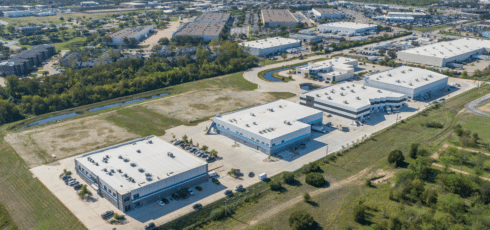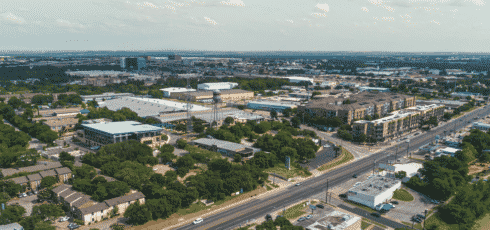This article was originally published in AQUILA’s 1Q 2022 Austin Industrial Market Report. This article will not be updated, but please contact us if you have specific questions regarding the information in this article.
If you haven’t heard, the semiconductor industry is booming. The Semiconductor Industry Association (SIA) announced global semiconductor industry sales hit a record of $555.9 billion in 2021 (a 26.2% YOY increase) and is forecasting 2022 sales to grow another 8.8%.
With so much demand, it’s no wonder semiconductor manufacturing companies have been buying and leasing industrial space at a rapid pace.
In this quarter’s special report, we wanted to dig into the past, present and future of Austin’s semiconductor industry. To do this, we’ve answered the following questions:
- What are semiconductors and why do we care?
- What’s the current state of the Austin semiconductor industry?
- What does the future hold for Austin’s semiconductor industry?
What Are Semiconductors and Why Do We Care?
Before we get too far into discussing Austin’s semiconductor industry, we first need to define what semiconductors are. According to Investopedia, a semiconductor is “a material that conducts electricity more than an insulator but less than a pure conductor.” To put it in simpler terms, semiconductors are the “brains” of most of the electronic devices we use in our everyday lives.
Also known as “chips,” semiconductors can be found in everything from our phones to our cars and medical equipment. Without them, our electronic devices would be brought to a standstill. This high degree of importance is why, when semiconductor supply chains began to slow down due to the COVID-19 pandemic, so many other supply chains were slowed or completely stopped as well. For example, according to J.P. Morgan, Volkswagen produced 800,000 fewer cars in 3Q 2021 than it did in 3Q 2020, and Toyota announced a 40% cut in car and truck production in October 2021.
The other primary reason semiconductors are top-of-mind is because the U.S. has played a smaller role in semiconductor manufacturing in recent years, an issue highlighted when overseas supply chains started to become strained. Despite the U.S. semiconductor industry supporting 277,000 direct jobs and 1.6 million indirect jobs, some would argue that’s not enough.
According to SIA’s 2021 industry report, the U.S. share of semiconductor manufacturing capacity dropped from 37% in 1990 to 12% today. East Asia now leads the world in semiconductor manufacturing capacity, with three-quarters of the worldwide capacity located there. This is why so many in the U.S. government and manufacturing industries have put so much focus on semiconductors.
What’s the Current State of the Austin Semiconductor Industry?
With the importance of semiconductors now established, let’s dive into the state of Austin’s semiconductor industry. Austin has historically been home to several large-scale semiconductor manufacturers and adjacent industries, a trend beginning to increase today.
Samsung is likely the most well-known semiconductor company in the Austin area. Its November 2021 announcement of a $17 billion, 2,000-job semiconductor fabrication plant in Taylor has been in the headlines recently, but Samsung’s Austin presence goes much further back. The Austin Business Journal shows Samsung to have 2.45 million square feet in Austin, growing from its original Austin factory opened in 1997.
Some of the largest players (semiconductor manufacturers or semiconductor-adjacent companies) according to Austin campus size in 2021 are:
- NXP Semiconductors – 2.68 million SF
- Samsung – 2.45 million SF
- Applied Materials – 2.04 million SF
- Infineon Technologies AG – 1.2 million SF
- AMD – +/- 560,000 SF
Semiconductor-related jobs are also on the uptick in the Austin MSA. Data provided by Emsi shows there are currently 11,458 jobs in the Semiconductor Machinery Manufacturing (333242) and Semiconductor and Related Device Manufacturing (334413) industry codes. For these industry codes, there are also 1,878 unique full-time, non-remote posted job openings as of this writing (compared to 541 in April 2019).
Companies in the Austin market competing for these employees are
- AMD – 658 current job openings
- Applied Materials – 456
- Tesla – 142
- Intel – 127
- NXP Semiconductors – 81
- Cirrus Logic – 77
What Does the Future Hold for Austin’s Semiconductor Industry?
So, with so much focus on the semiconductor industry, how much of an impact could this have on Austin’s future?
As it turns out, quite a bit.
For starters, the $52 billion CHIPS Act currently making its way through the federal government could lead to significant growth in the United State’s chip manufacturing capabilities. The act is intended to provide incentives to semiconductor manufacturers which will, hopefully, encourage an expansion of manufacturing facilities and an increased demand for industrial space. The Austin market will undoubtedly benefit from this increased demand for space. It would not be surprising to see existing Austin chip manufacturers growing their footprint and newcomers to the Austin market beginning to filter in.
The FABS Act, another initiative being pushed forward by the federal government, would further incentivize semiconductor manufacturing through the use of tax credits. The act would offer firms a 25% tax credit for facilities and equipment used to design or process chips. This act would be another significant incentive that could lead to a further increase in demand for industrial space.
There are also more local initiatives and headlines that could lead to increased growth of Austin’s semiconductor industry. Texas governor Greg Abbot established a semiconductor task force to help attract semiconductor investment into the state, and the Austin Chamber has expressed strong support for both the CHIPS Act and FABS Act. Other firms are already announcing potential plans to grow in the Austin area, such as Applied Materials’ potential $2 billion project in Hutto and Micron’s potential Austin area factory.
It is a critical time to be investing in American manufacturing of semiconductor chips.”
We may not be able to tell the future with 100% accuracy, but we are fairly confident about where the Austin semiconductor market is headed.
Conclusion
We hope this deep dive into the Austin semiconductor market has given you a good idea of why this industry has become so important over the last two years. With so much demand in the pipeline, it will be interesting to see how Austin’s industrial market continues to evolve and grow to accommodate the wave of new semiconductor tenants we hope will soon be knocking at the door.












